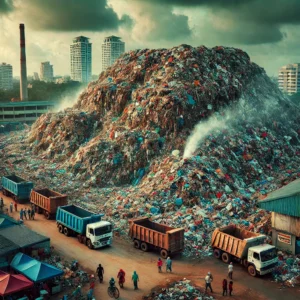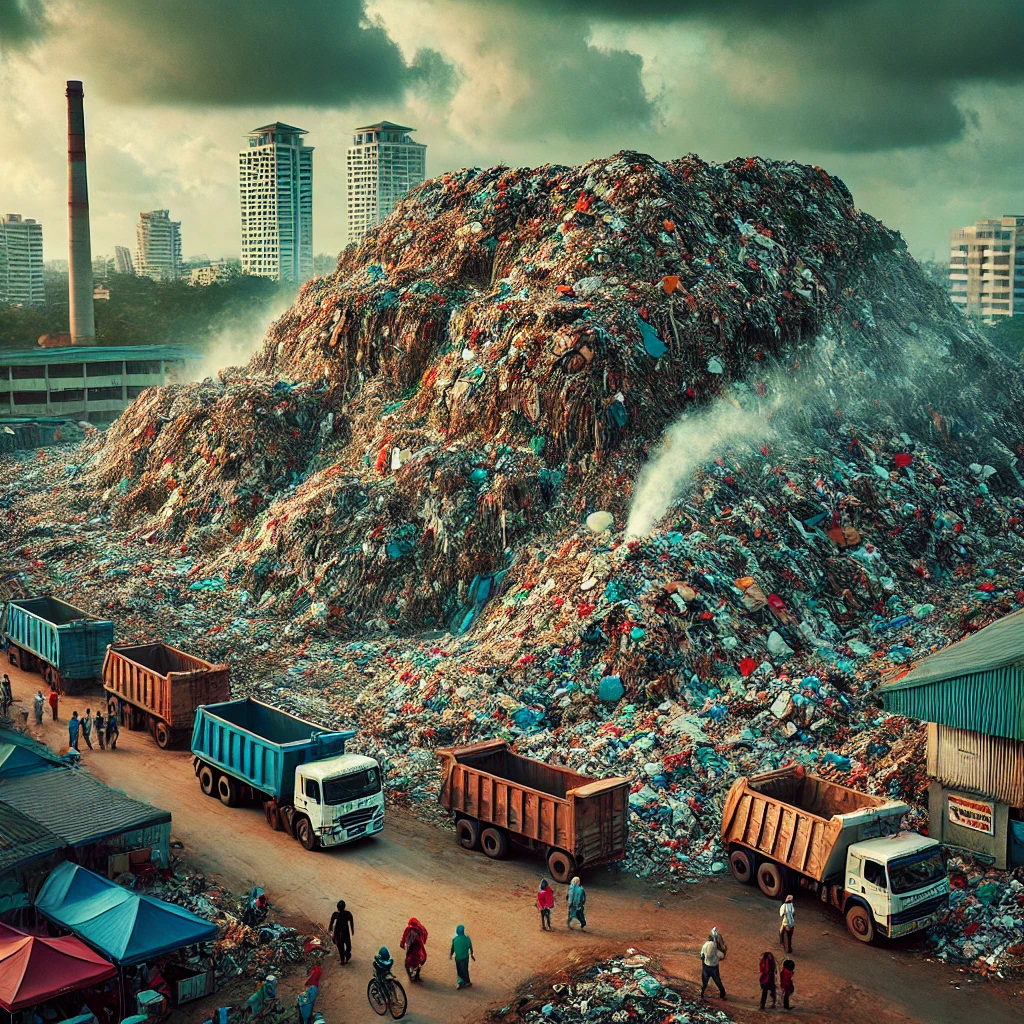Madampitiya Garbage Dump Threatens Colombo’s Urban Future
The Madampitiya garbage dump, towering at a staggering height of 15 meters, is rapidly becoming a source of concern for residents living in its shadow. The Colombo Municipal Council (CMC) has raised alarms, with the site now posing a significant threat to the health and safety of those in the surrounding neighbourhoods.

Shahina Mysan, the director of engineering for solid waste management at the CMC, explained the alarming situation. “The dump spans two to three acres, and with garbage now piled up to about 15 meters, it poses a potential risk to the community, especially during the rainy season,” she said.
Located in Colombo 15, about 4 kilometers from the city center, the Madampitiya site is surrounded by schools, restaurants, and shops—areas with high foot traffic. This site has become Colombo’s only non-degradable waste dump following the closure of the Meethotamulla and Bloemendhal sites in recent years. But despite its crucial role, it has become increasingly problematic as Colombo’s waste generation continues to soar.
Under the “Clean Sri Lanka” initiative, alongside ongoing infrastructure projects like the Port City and rising high-rise buildings, waste generation in the city is projected to surge over the next 40 to 50 years. This means that the CMC will face even more significant challenges in managing waste while striving to maintain environmental sustainability.
“We must be prepared to manage this growing demand,” Ms. Mysan added in an interview with the Sunday Times, “and ensure that we do so in an environmentally responsible way. If we don’t address this issue, the volume of waste at Madampitiya will continue to increase, creating more challenges.”

The CMC director also emphasized the need for immediate action, urging the Urban Development Authority to allocate land for new waste management facilities. “Otherwise, we risk seeing a situation like Meethotamulla again—one that could devastate lives and the environment,” she warned.
The tragic collapse of the Meethotamulla garbage dump in 2017, which claimed the lives of 32 people, remains a stark reminder of the dangers posed by poorly managed waste disposal sites. This disaster has made many, including Ms. Mysan, deeply concerned about the future of waste management in Colombo.
Despite these concerns, there is hope on the horizon. Dr. N.G. Anura Karunathilake, Minister of Urban Development, Construction, and Housing, responded to Ms. Mysan’s calls for action. “We are well aware of the concerns regarding waste management in Colombo, and the government is moving forward with the Aruwakkalu waste disposal project,” he said. “By the end of this year, operations at the Aruwakkalu site will begin, focusing mainly on non-degradable waste. We aim to address the excessive waste buildup at Madampitiya and eventually reduce the pressure on the site.”
The Aruwakkalu facility, located in Puttalam, is expected to handle up to 1,200 tons of waste daily, with waste transported from Colombo via special trains. Testing at the site is scheduled to begin by the end of March or early April, and authorities are optimistic that it will help alleviate the burden on Colombo’s overworked waste disposal systems.
In addition to Aruwakkalu, Dr. Karunathilake highlighted the government’s efforts to expand waste management initiatives, including a waste-to-energy plant in collaboration with the Korean government. A feasibility study is currently underway, with the plant expected to begin operations by 2027 in Kerawalapitiya.
While these developments offer some promise, experts argue that the key to long-term sustainability lies in changing public behavior. Many Sri Lankans continue to have limited awareness of proper waste disposal practices, often dumping trash in public spaces or failing to sort recyclables. Minister Karunathilake and Ms. Mysan both emphasized the media’s role in educating the public and urged the government to foster a culture of environmental responsibility from an early age.
“Public awareness is crucial,” Ms. Mysan said. “We need to instill a sense of ownership in people, so they take responsibility for keeping their surroundings clean.”

Dr. Karunathilake also noted the importance of the Environmental Police in enforcing waste management laws, though both officials acknowledged that illegal dumping remains a significant problem. Ms. Mysan, in particular, highlighted the lack of proactive action by the Environmental Police, despite the presence of legal frameworks to address pollution.
“I’ve raised this concern in every meeting I’ve attended,” she said. “We need the Environmental Police to be more active in addressing illegal dumping, especially in areas like Borella and Punchi Borella, where garbage is often discarded in hidden spaces.”
For now, the CMC continues to collaborate with law enforcement, providing CCTV footage to support legal action against violators. But as the issue of waste management grows ever more urgent, it is clear that Colombo’s future depends not only on government initiatives but also on the willingness of its citizens to take responsibility for their environment.
In the wake of past disasters and with new challenges looming on the horizon, it is crucial that Sri Lanka’s waste management systems evolve to meet the demands of its growing urban population. Failure to act now could result in another disaster, and this time, the cost could be even higher.
As Colombo continues to expand, one thing is certain: the city must address its waste disposal crisis before it becomes a catastrophe too great to manage.







